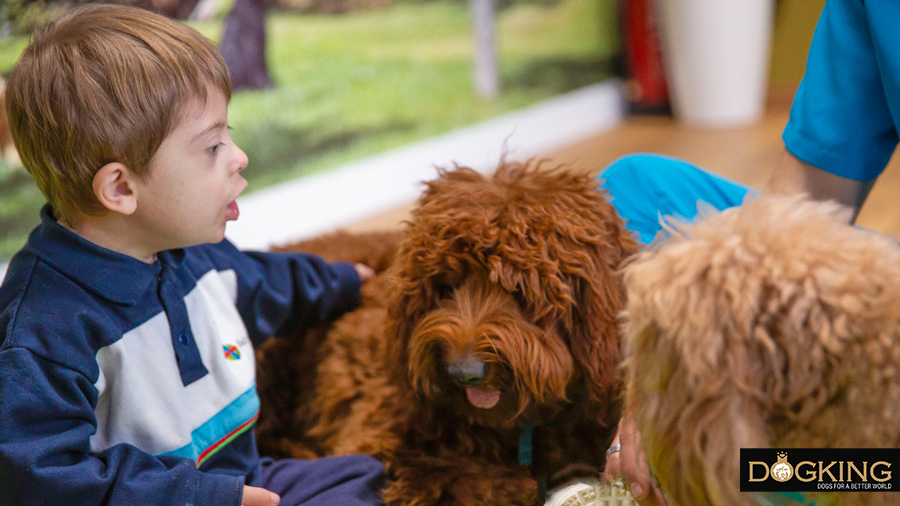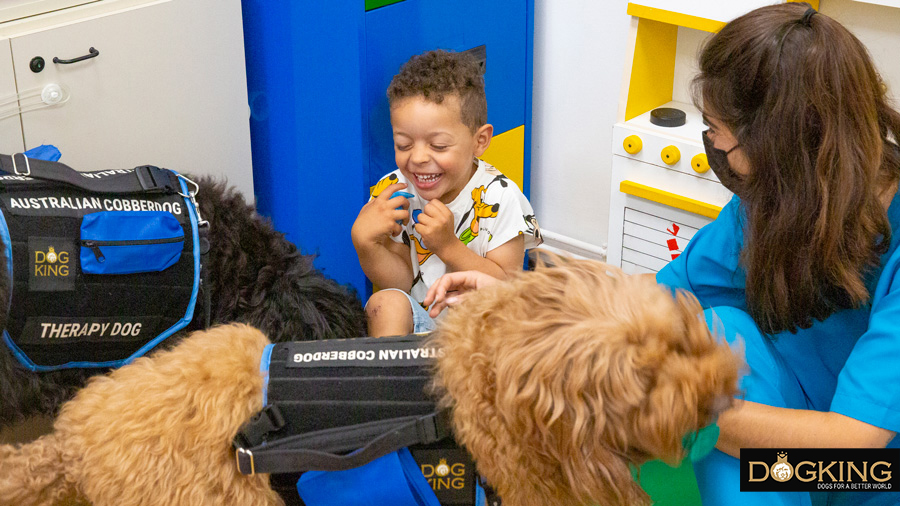Pourquoi les Australian Cobberdogs sont-ils hypoallergéniques ?
La race par excellence, sans perte de poils ni de pellicules

LA RACE THÉRAPEUTIQUE PIONNIÈRE DANS LE MONDE DES ALLERGIES
Temps de lecture approximatif : 7 minutes
Environ 10 % de la population mondiale est allergique aux chiens. En même temps, 14 % des chiens abandonnés le sont en raison de problèmes allergiques. Chez DOGKING, nous croyons que tout le monde a le droit de profiter de l'amour d'un chien, tout comme chaque chien mérite de savoir ce que c'est que d'avoir une maison. C'est pourquoi nous nous engageons à faire connaître les Australian Cobberdogs, une race hypoallergénique qui a réussi à établir un lien même avec des personnes dont le système immunitaire est le plus sensibilisé aux canins. Cependant, qu'est-ce qui rend cela possible ?

Table de matières
L'allergie aux chiens : quelles en sont les causes ?
Bien que l'on pense communément que l'allergie aux chiens est causée par leur poil, il s'avère que la personne allergique a développé une hypersensibilité à une protéine présente dans les squames, les lésions cutanées du chien, produites par les glandes sébacées et la salive. Ces particules s'imprègnent là où notre chien passe, se retrouvant dans l'air, sur les objets, voire sur la peau ou les vêtements des personnes. C'est pourquoi, même si un chien n'est pas présent au même endroit que nous, nous pouvons avoir des symptômes d'allergie s'il a été là auparavant. Cet effet est aggravé lorsque le chien se lèche, car la quantité d'allergène sera plus importante sur son pelage. De plus, s'il s'agit d'un chien qui perd souvent ses poils, il y a plus de chances qu'une personne sensible subisse une réaction. Non seulement il laissera des poils contenant la protéine potentiellement allergène, mais la mue entraînera également des squames contenant cette même substance.
Le Australian Cobberdog et son pouvoir hypoallergénique
La raison principale est que le pelage de ces chiens ne mue pas et ne perd pas de poils, et (sauf en cas de problème dermatologique inhabituel qui spécifie le contraire) il ne présente pas de pellicules. Cela fait que la protéine qui, dans la plupart des chiens, se retrouverait imprégnée dans leur poil et leurs squames cutanées, ne se propage pas dans le cas de l'Australian Cobberdog et, par conséquent, ne provoque pas de symptômes allergiques. De plus, le pourcentage de personnes ayant des allergies à la salive de ces canins est encore très faible. En effet, étant donné que toutes les personnes ne sont pas identiques, elles ne réagiront pas de la même manière à certains facteurs, et il n'existe pas de chien qui soit universellement hypoallergénique. Mais ce qui est certain, c'est que les Australian Cobberdogs ont aidé de nombreuses personnes, familles et patients à profiter de la compagnie d'un chien. Une compagnie qu'ils croyaient jusqu'alors impossible en raison de leur condition allergique.
La race comme garantie hypoallergénique
Le standard de l'Australian Cobberdog repose sur deux piliers : un tempérament apte à en faire un chien de thérapie et d'assistance, et un pelage hypoallergénique qui ne mue pas. Tout cela dans le but de préserver l'essence, l'excellence et l'authenticité de la race, afin que l'Australian Cobberdog soit et reste le chien équilibré et sain que nous connaissons aujourd'hui, et puisse continuer à aider des milliers de personnes.
Chez DOGKING, nous nous occupons de veiller à la préservation de la séquence ADN de la race en suivant les standards de la MDBA. C'est pourquoi nous utilisons cette race à des fins thérapeutiques, en intervenant dans des hôpitaux et des associations pour personnes ayant des besoins spéciaux.
